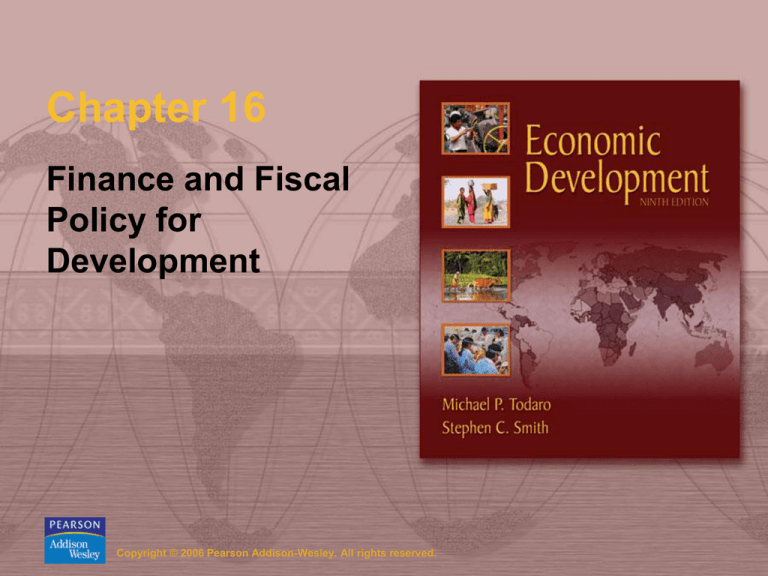
Chapter 16
Finance and Fiscal
Policy for
Development
Copyright © 2006 Pearson Addison-Wesley. All rights reserved.
The Role of the Financial System
Providing payment services
Matching savers and investors
Generating/distributing information
Allocating credit efficiently
Pricing, pooling, and trading risks
Increasing asset liquidity
Copyright © 2006 Pearson Addison-Wesley. All rights reserved.
16-2
The Painful Road to
Macroeconomic Stability
Macro stabilization has three main
objectives:
– Controlling inflation
– Restoring fiscal balance by reducing
governmental spending and by raising
government tax revenues
– Eliminating the current account deficit by means
of devaluation and export promotion
Copyright © 2006 Pearson Addison-Wesley. All rights reserved.
16-3
Financial Systems and Monetary
Policy
Differences between MDC and LDC
financial systems
The role of central banks
Copyright © 2006 Pearson Addison-Wesley. All rights reserved.
16-4
Table 16.1
Copyright © 2006 Pearson Addison-Wesley. All rights reserved.
16-5
Financial Systems and Monetary
Policy
Differences between MDC and LDC
financial systems
The role of central banks
The emergence of development banking
The role of informal finance, group lending,
and microfinance institutions for small-scale
enterprise
Copyright © 2006 Pearson Addison-Wesley. All rights reserved.
16-6
Reforming Financial Systems
Financial liberalization, real interest rates,
savings, and investment
Copyright © 2006 Pearson Addison-Wesley. All rights reserved.
16-7
Figure 16.1
Copyright © 2006 Pearson Addison-Wesley. All rights reserved.
16-8
Reforming Third World Financial
Systems
Financial liberalization, real interest rates,
savings, and investment
Financial policy and the role of the state
Stock markets
Copyright © 2006 Pearson Addison-Wesley. All rights reserved.
16-9
Fiscal Policy for Development
Macro stability and resource mobilization
Taxation: direct and indirect
– Personal income and property taxes
– Corporate income taxes
– Indirect commodity taxes
– Problems of tax administration
Copyright © 2006 Pearson Addison-Wesley. All rights reserved.
16-10
Table 16.2
Copyright © 2006 Pearson Addison-Wesley. All rights reserved.
16-11
Table 16.3
Copyright © 2006 Pearson Addison-Wesley. All rights reserved.
16-12
Public Administration: the
Scarcest Resource
Managerial/administrative capability is
scarce because of:
– A lack of training or experience
– Political instability
Class, tribal, or religious conflict make public
administration difficult
Bureaucracies are often overstaffed at the
bottom and understaffed at the top
Copyright © 2006 Pearson Addison-Wesley. All rights reserved.
16-13
State-Owned Enterprises (SOEs)
Definition and description
Improving the performance of SOEs
Privatization: theory and experience
Copyright © 2006 Pearson Addison-Wesley. All rights reserved.
16-14
Table 16.4
Copyright © 2006 Pearson Addison-Wesley. All rights reserved.
16-15
Military Expenditures and
Economic Development
Significance and economic impact
Copyright © 2006 Pearson Addison-Wesley. All rights reserved.
16-16
Table 16.5
Copyright © 2006 Pearson Addison-Wesley. All rights reserved.
16-17
Table 16.6
Copyright © 2006 Pearson Addison-Wesley. All rights reserved.
16-18
Table 16.7
Copyright © 2006 Pearson Addison-Wesley. All rights reserved.
16-19
Military Expenditures and
Economic Development
Significance and economic impact
The end of the cold war: disarmament,
conflict resolution, and human development
Copyright © 2006 Pearson Addison-Wesley. All rights reserved.
16-20
Concepts for Review
Central bank
Currency board
Currency substitution
Development banks
Direct taxes
Financial liberalization
Financial repression
Copyright © 2006 Pearson Addison-Wesley. All rights reserved.
Group lending
schemes
Indirect taxes
Informal finance
Macroeconomic
stabilization
Monetary policy
Money supply
16-21
Concepts for Review (cont’d)
Organized money
markets
Privatization
Rationing
Rotating savings and
credit associations
Copyright © 2006 Pearson Addison-Wesley. All rights reserved.
State-owned
enterprises
Transparency
Unorganized money
markets
16-22







